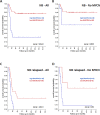Identification of GALNT14 as a novel neuroblastoma predisposition gene
- PMID: 26309160
- PMCID: PMC4694905
- DOI: 10.18632/oncotarget.4501
Identification of GALNT14 as a novel neuroblastoma predisposition gene
Abstract
Although several genes have been associated to neuroblastoma (NB) predisposition and aggressiveness, further genes are likely involved in the overall risk of developing this pediatric cancer. We thus carried out whole-exome sequencing on germline DNA from two affected second cousins and two unlinked healthy relatives from a large family with hereditary NB. Bioinformatics analysis revealed 6999 variations that were exclusively shared by the two familial NB cases. We then considered for further analysis all unknown or rare missense mutations, which involved 30 genes. Validation and analysis of these variants led to identify a GALNT14 mutation (c.802C > T) that properly segregated in the family and was predicted as functionally damaging by PolyPhen2 and SIFT. Screening of 8 additional NB families and 167 sporadic cases revealed this GALNT14 mutation in the tumors of two twins and in the germline of one sporadic NB patient. Moreover, a significant association between MYCN amplification and GALNT14 expression was observed in both NB patients and cell lines. Also, GALNT14 higher expression is associated with a worse OS in a public dataset of 88 NB samples (http://r2.amc.nl). GALNT14 is a member of the polypeptide N-acetylgalactosaminyl-transferase family and maps closely to ALK on 2p23.1, a region we previously discovered in linkage with NB in the family here considered. The aberrant function of GALNTs can result in altered glycoproteins that have been associated to the promotion of tumor aggressiveness in various cancers. Although rare, the recurrence of this mutation suggests GALNT14 as a novel gene potentially involved in NB predisposition.
Keywords: GALNT14; O-glycosylation; exome-sequencing; genetic predisposition; neuroblastoma.
Conflict of interest statement
The authors declare no conflict of interest.
Figures






References
-
- Brodeur GM. Neuroblastoma: biological insights into a clinical enigma. Nat Rev Cancer. 2003;3:203–16. Review. - PubMed
-
- Maris JM, Hogarty MD, Bagatell R, Cohn SL. Neuroblastoma. Lancet. 2007;369:2106–20. - PubMed
-
- Longo L, Tonini GP, Ceccherini I, Perri P. Oligogenic inheritance in neuroblastoma. Cancer Lett. 2005;228:65–9. - PubMed
-
- Heck JE, Ritz B, Hung RJ, Hashibe M, Boffetta P. The epidemiology of neuroblastoma: a review. Paediatr Perinat Epidemiol. 2009;23:125–43. - PubMed
Publication types
MeSH terms
Substances
LinkOut - more resources
Full Text Sources
Other Literature Sources
Medical

